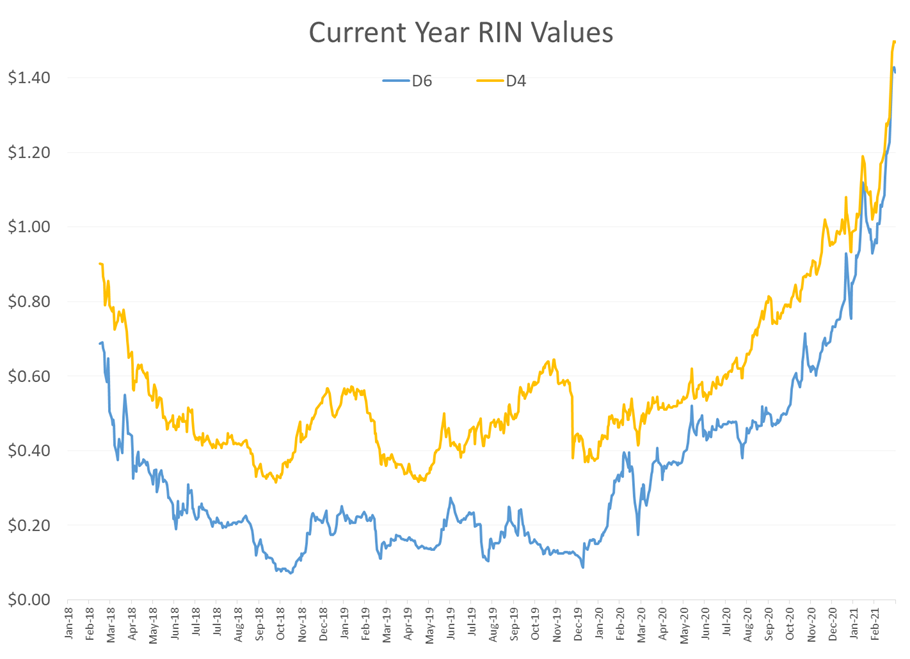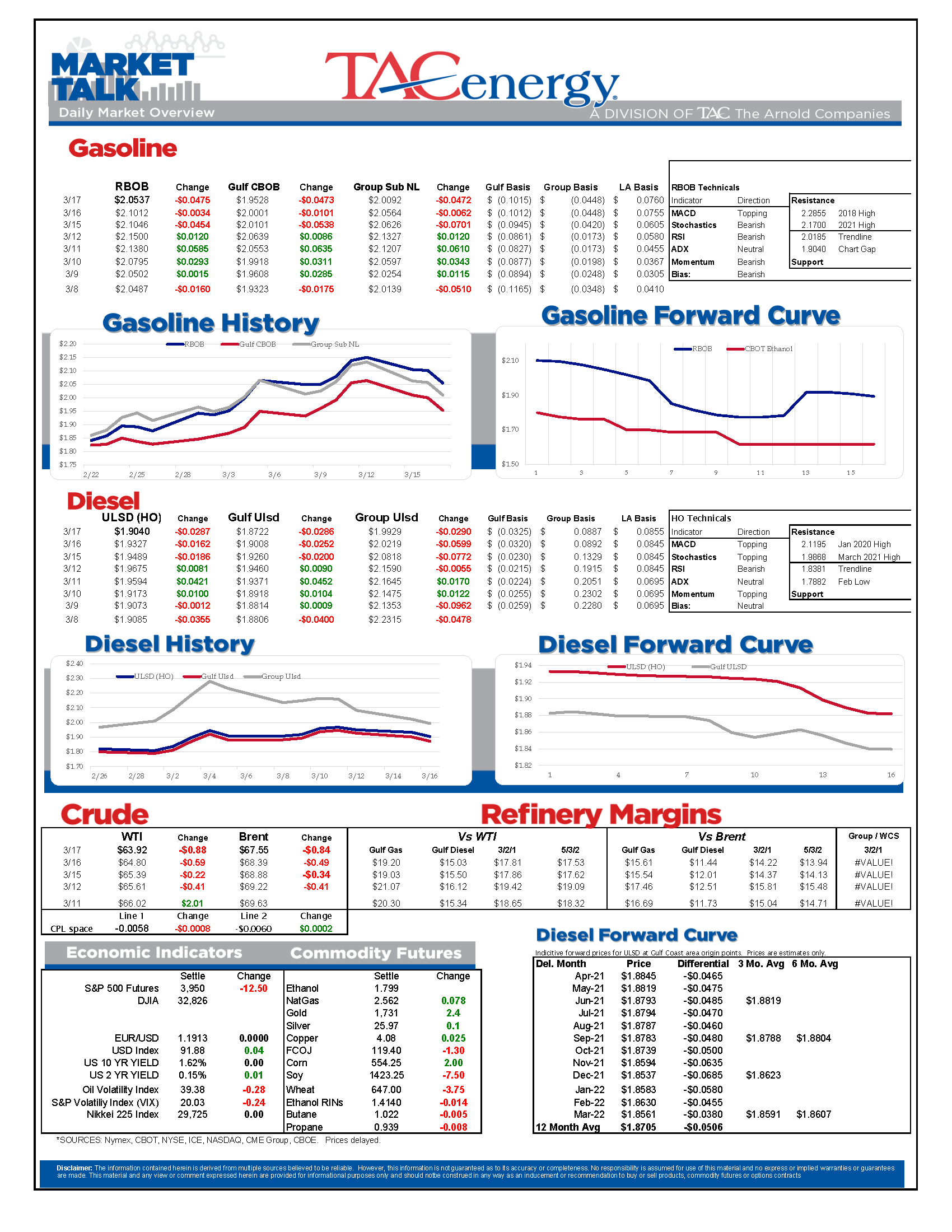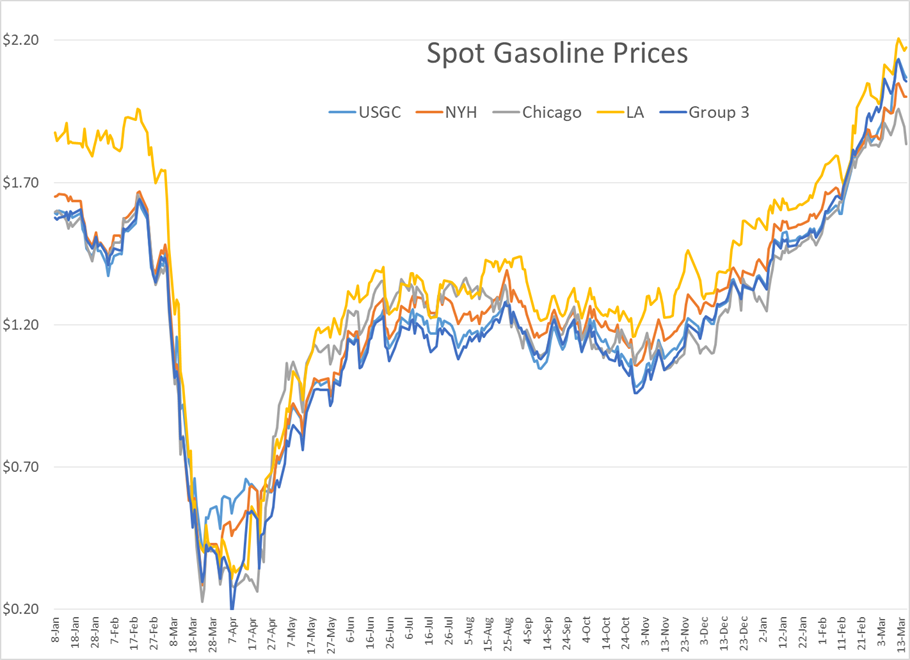IEA Increases Global Demand Forecast

No luck for the bulls so far this morning as the energy complex is facing a wave of selling for a third straight day. RBOB gasoline futures are once again leading the move lower, after a furious late day rally briefly pushed gasoline prices into positive territory Tuesday, only to fall back into the red just before settlement. Some technical analysts view a failed rally attempt like we saw yesterday as a bearish signal, since buyers are unable to gather enough momentum to end the day on a strong note, and that theory is looking good at the moment, now we’ll see if it lasts the day.
This selloff has ULSD futures roughly three cents away from the trend-line that’s held the rally since November 1, while RBOB futures will need to break below $2 this week in order to follow suit. Whether or not we see prices break that trend will likely be pivotal in determining if the $2.17 mark set early Monday will prove to be the high trade of the year. If so, we’d expect another 20-30 cents of downside on gasoline prices if the seasonal rally unwinds like it does most years.
The IEA increased its global demand forecast in its latest monthly oil market report, but also suggested that the spare capacity of oil production sitting on the sidelines was more than capable of handling that increase. The IEA report seems to throw cold water on recent Bank reports suggesting a new commodity supercycle that will send oil prices much higher in the coming years.
The API reported more pedestrian changes in inventory levels last week, in comparison to the past two record setting weeks. Crude & Gasoline stocks were both down around one million barrels, while distillates grew by a little under one million barrels. The DOE’s weekly report is due out at its normal time this morning, with the refinery runs the key figure to watch as it’s still hard to decipher what units at what facilities have returned to normal levels after the February freeze.
Supply allocations, particularly for diesel and premium gasoline grades, remain tight across the southern half of the country, with occasional outages continuing to pop up from New Mexico through the South East. Easing cash market differentials in most regions besides the West Coast suggest that resupplies are on the way, but it will probably be about another week or more before the markets further from the refining hubs start to feel some relief.
RIN prices seem to be catching their breath after a strong rally that approached all-time highs Monday. The AFPM sent a letter to the EPA urging it to act since the spike in prices, which it argues are partially caused by the agency not meeting its deadline to set obligation levels, are threatening to put more refiners out of business. A change in stance from the EPA back in 2013 helped RIN values drop by more than $1/RIN, so any reaction or lack of from the agency will certainly be market moving news.
Click here to download a PDF of today's TACenergy Market Talk.
Latest Posts
Week 17 - US DOE Inventory Recap
The Energy Complex Is Trading Modestly Lower So Far This Morning With WTI Crude Oil Futures Leading The Way
Energy Futures Are Drifting Quietly Higher This Morning
Refined Products Holding Close To Break Even While Oil Prices Are Losing Just Under 1%
Social Media
News & Views
View All
Week 17 - US DOE Inventory Recap

The Energy Complex Is Trading Modestly Lower So Far This Morning With WTI Crude Oil Futures Leading The Way
The energy complex is trading modestly lower so far this morning with WTI crude oil futures leading the way, exchanging hands $1.50 per barrel lower (-1.9%) than Tuesday’s settlement price. Gasoline and diesel futures are following suit, dropping .0390 and .0280 per gallon, respectively.
A surprise crude oil build (one that doesn’t include any changes to the SPR) as reported by the American Petroleum Institute late Tuesday is taking credit for the bearish trading seen this morning. The Institute estimated an increase in crude inventories of ~5 million barrels and drop in both refined product stocks of 1.5-2.2 million barrels for the week ending April 26. The Department of Energy’s official report is due out at it’s regular time (9:30 CDT) this morning.
The Senate Budget Committee is scheduled to hold a hearing at 9:00 AM EST this morning regarding a years-long probe into climate change messaging from big oil companies. Following a 3-year investigation, Senate and House Democrats released their final report yesterday alleging major oil companies have internally recognized the impacts of fossil fuels on the climate since as far back as the 1960s, while privately lobbying against climate legislation and publicly presenting a narrative that undermines a connection between the two. Whether this will have a tangible effect on policy or is just the latest announcement in an election-yeardeluge is yet to be seen.
Speaking of deluge, another drone attack was launched against Russian infrastructure earlier this morning, causing an explosion and subsequent fire at Rosneft’s Ryazan refinery. While likely a response to the five killed from Russian missile strikes in Odesa and Kharkiv, Kyiv has yet to officially claim responsibility for the attack that successfully struck state infrastructure just 130 miles from Moscow.
The crude oil bears are on a tear this past week, blowing past WTI’s 5 and 10 day moving averages on Monday and opening below it’s 50-day MA this morning. The $80 level is likely a key resistance level, below which the path is open for the American oil benchmark to drop to the $75 level in short order.
Click here to download a PDF of today's TACenergy Market Talk.

Energy Futures Are Drifting Quietly Higher This Morning
Energy futures are drifting quietly higher this morning as a new round of hostage negotiations between Israel and Hamas seem to show relative promise. It seems the market is focusing on the prospect of cooler heads prevailing, rather than the pervasive rocket/drone exchanges, the latest of which took place over Israel’s northern border.
A warmer-than-expected winter depressed diesel demand and, likewise, distillate refinery margins, which has dropped to its lowest level since the beginning of 2022. The ULSD forward curve has shifted into contango (carry) over the past month as traders seek to store their diesel inventories and hope for a pickup in demand, domestic or otherwise.
The DOE announced it had continued rebuilding it’s Strategic Petroleum Reserve this month, noting the addition of 2.3 million barrels of crude so far in April. Depending on what the private sector reported for last week, Wednesday’s DOE report may put current national crude oil inventories (include those of the SPR) above the year’s previous levels, something we haven’t seen since April of 2022, two months after Ukraine war began.
The latest in the Dangote Refinery Saga: Credit stall-out, rising oil prices, and currency exchange.
Click here to download a PDF of today's TACenergy Market Talk.





